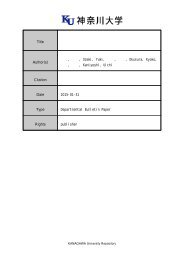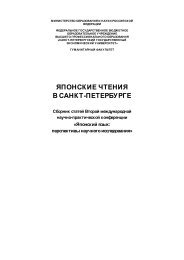to Learners with Special Educational Needs
e-textbook SEN
e-textbook SEN
Create successful ePaper yourself
Turn your PDF publications into a flip-book with our unique Google optimized e-Paper software.
Pokrivčáková, S. et al. (2015). Teaching Foreign Languages <strong>to</strong> <strong>Learners</strong> <strong>with</strong> <strong>Special</strong> <strong>Educational</strong> <strong>Needs</strong>:<br />
e-textbook for foreign language teachers. Nitra: Constantine the Philosopher University. 128 p.<br />
ISBN 978-80-558-0941-0<br />
Specific teaching methods and strategies<br />
Teachers in primary level spend a lot of time <strong>with</strong> their pupils. This gives them opportunity <strong>to</strong><br />
know their pupils, <strong>to</strong> understand their strength and weaknesses and help them <strong>to</strong> find the most<br />
appropriate strategies for effective learning. However, pupils since lower secondary level<br />
sometime move from class <strong>to</strong> class and from teacher <strong>to</strong> teacher and they see most of teachers 2<br />
or three times a week for no more than 45 minutes.<br />
Reid distinguishes three main components in the information processing cycle, namely,<br />
input, cognition and output and he suggests the following strategies that might be applied in<br />
different stages (2005, p. 32-33):<br />
Input<br />
At the input stage it is important <strong>to</strong>:<br />
• present information in small units;<br />
• moni<strong>to</strong>r at frequent intervals <strong>to</strong> ensure that the student is comprehending;<br />
• utilise overlearning, and vary this, using a range of materials and strategies; and<br />
• present key points at the initial stage of learning new material.<br />
Cognition<br />
At the cognition stage it can be important <strong>to</strong>:<br />
• encourage organisational strategies <strong>to</strong> help <strong>with</strong> learning;<br />
• organise new material <strong>to</strong> be learned in<strong>to</strong> meaningful chunks or categories;<br />
• relate the new information <strong>to</strong> previous knowledge <strong>to</strong> ensure that concepts are clearly<br />
unders<strong>to</strong>od;<br />
• place the information in<strong>to</strong> a meaningful framework;<br />
• utilise specific memory strategies, such as mind mapping and mnemonics; and<br />
• moni<strong>to</strong>r and assess the new learning frequently.<br />
Output<br />
At the output stage:<br />
• use headings and subheadings in written work <strong>to</strong> help provide a structure;<br />
• encourage the use of summaries in order <strong>to</strong> identify the key points; and<br />
• assess learning at each point.<br />
Homolová (2012, p. 51) uses the term strategopedia and referring <strong>to</strong> Rogers (2003) stresses<br />
the importance of knowing the most efficient learning strategies for student. It is important <strong>to</strong><br />
help student <strong>to</strong> find his/her own way of learning and help him <strong>to</strong> become au<strong>to</strong>nomous. It is<br />
equally important <strong>to</strong> teach dyslexic learners <strong>to</strong> use the compensation strategies.<br />
Multisensory approach<br />
Concerning language teaching methods applied in a group of dyslexic students results of<br />
many researches and studies indicate that TPR, audio-oral method and especially multisensory<br />
structured learning (MSL) approach.<br />
Multisensory approach has been proved <strong>to</strong> be efficient and useful for all students but it is of<br />
great importance for dyslexic learners. In case of involving more senses we may compensate<br />
their visual deficits. More senses are involved at the same time.<br />
MSL approach presents and teaches L2 “through the activation of audi<strong>to</strong>ry, visual, tactile and<br />
kinaesthetic pathways” (Kormos & Smith, 2012, p. 127). As it has been mentioned, many<br />
dyslexic students have problems <strong>with</strong> phonological processing skills and thus applying images,<br />
sounds or <strong>to</strong>uch is a way of compensation. For example, bringing real objects in<strong>to</strong> the classroom<br />
enables learners <strong>to</strong> apply additional sensory chancels rather than encoding the words, texts<br />
verbally. At the same time it helps them <strong>to</strong> apply different direct learning strategies as applying<br />
images, sounds or associations. Kormos and Smith (ibid) claim that “additionally, the modeling<br />
of affective strategies, such as rewarding oneself when completing a task, might assist language<br />
learners <strong>with</strong> an SpLD <strong>to</strong> overcome any anxiety and stress they might experience”.<br />
46






